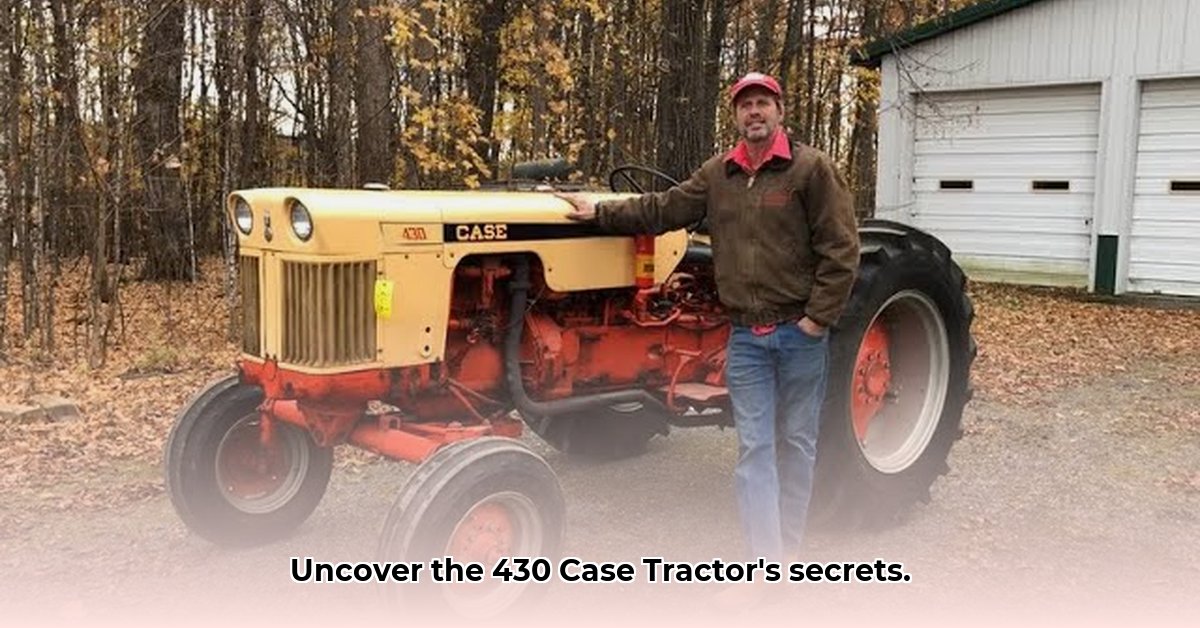
The J.I. Case 430 tractor, a stalwart of the 1960s agricultural landscape, represents more than just a machine; it's a symbol of a bygone era of farming ingenuity and robust engineering. Manufactured from 1960 to 1969, this versatile workhorse earned its place in the hearts of farmers and collectors alike. This comprehensive guide delves into the 430's history, technical specifications, and restoration, providing insights for enthusiasts and historians. We will explore its design, evolution, operational aspects, and lasting impact on the agricultural machinery sector. For even more in-depth information, check out this dedicated website.
A Legacy of Dependability: The J.I. Case 430
Produced during a pivotal period in agricultural technology, the Case 430 was a testament to robust design and straightforward functionality. Its compact size made it ideal for smaller farms and tighter spaces, distinguishing it from larger, more specialized tractors of the time. But how did its simple design translate to its enduring popularity? Was its reliability, ease of maintenance and cost of operation a significant factor in its success?
Were the advancements introduced over its decade long production run key factors in its sustained success? Yes, the introduction of power steering and an independent PTO substantially improved both operator comfort and operational efficiency. The availability of multiple front-end loader options further enhanced its versatility. The 430's enduring appeal stems from its reliability, ease of maintenance, and adaptability to various farming tasks.
Technical Specifications: Power and Precision
The Case 430's core component is its 3.1-liter, four-cylinder diesel engine. While horsepower figures vary slightly across sources (approximately 34 to 38 hp), this discrepancy likely reflects differing measurement methodologies—engine horsepower versus PTO (Power Take-Off) horsepower. Engine horsepower measures raw engine power, while PTO horsepower reflects power delivered to implements. Understanding this distinction is crucial for accurate assessment.
Further enhancing its adaptability, the 430 offered a range of transmission options: a basic four-speed, a twelve-speed (unsynchronized), and an eight-speed with a convenient shuttle shift for easier forward/reverse changes. A 13-gallon fuel tank ensured sufficient operational endurance.
| Specification | Value | Notes |
|---|---|---|
| Engine | 3.1L four-cylinder diesel | Case-manufactured; known for its ruggedness and reliability |
| Horsepower | ~34-38 hp | Variation depends on measurement method (engine vs. PTO hp) |
| Transmission | 4-speed, 8-speed, 12-speed | Operator preference and task-specific needs influenced choice |
| Fuel Tank Capacity | 13 US gallons (49.2 liters) | Ample for extended field work |
| PTO | Mechanical, speed varied by model | Independent PTO available on later models |
| Steering | Manual (early models), Power (later) | Significantly improved maneuverability in later iterations |
| Production Years | 1960-1969 | Consistent production across a decade |
Evolution and Innovation: A Decade of Refinement
Throughout its decade-long production, the 430 underwent continuous refinement. The addition of power steering in 1965 dramatically improved operator comfort and maneuverability, particularly during extended operation. The introduction of an independent PTO in 1966 granted operators greater precision and control over implements. This evolution reflects Case's dedication to enhancing both performance and user experience.
What other enhancements were pivotal during its production run? Multiple front-end loader options (models 295, 391, and 392) were introduced, expanding the 430's capabilities from a simple tractor to a versatile tool handling various farming operations. These choices allowed farmers to tailor their 430 to their specific needs.
Operational Aspects and Common Challenges
The Case 430 proved exceptionally versatile, handling a wide range of tasks from plowing and planting to cultivating and hauling. However, like any machinery, regular maintenance was essential. Common issues encountered by owners often centered on the transmission and hydraulic systems, highlighting the importance of preventative maintenance. Sourcing replacement parts for older models might present some difficulty, but dedicated online communities and specialized suppliers offer solutions to this challenge.
Legacy and Restoration: Preserving a Piece of History
The J.I. Case 430's enduring appeal speaks volumes about its reliable design and simple elegance. The relatively straightforward mechanics of the tractor have made it a popular choice for restoration projects. What makes restoring a 430 so rewarding for collectors? The deep satisfaction of reviving a piece of agricultural history and the creation of a fully functional piece of history.
Restoring Your 430: A Practical Guide
Restoring a Case 430 is a significant undertaking demanding patience and mechanical aptitude. Follow these steps for a successful restoration:
- Assessment: Thoroughly inspect the tractor, documenting its condition, missing parts, and areas needing repair. This step forms the foundation of the entire project.
- Parts Acquisition: Source necessary parts. While original parts are preferable, high-quality aftermarket alternatives are often available.
- Disassembly: Carefully dismantle the tractor, meticulously documenting each step with photos and notes. This will be vital for reassembly.
- Repair and Replacement: Repair or replace damaged components, prioritizing essential systems (engine, transmission).
- Reassembly: Carefully reassemble the tractor, referring to your documentation. Thorough checking is crucial.
- Testing and Refinement: Test all systems, making adjustments as needed. This phase is iterative; expect to fine-tune various components.
A successfully restored Case 430 stands as a testament to dedication, mechanical skill, and a profound appreciation for agricultural heritage. It's more than just a machine; it's a tangible link to the past.
Key Takeaways:
- The J.I. Case 430, a product of 1960-1969, holds significant value in agricultural history.
- Restoring a 430 is challenging yet profoundly rewarding.
- Parts availability and cost of parts can significantly impact restoration.
- Thorough understanding of the tractor's workings and sourcing reliable information is critical for success.
- A restored 430 is a valuable asset, a source of immense pride and satisfaction.